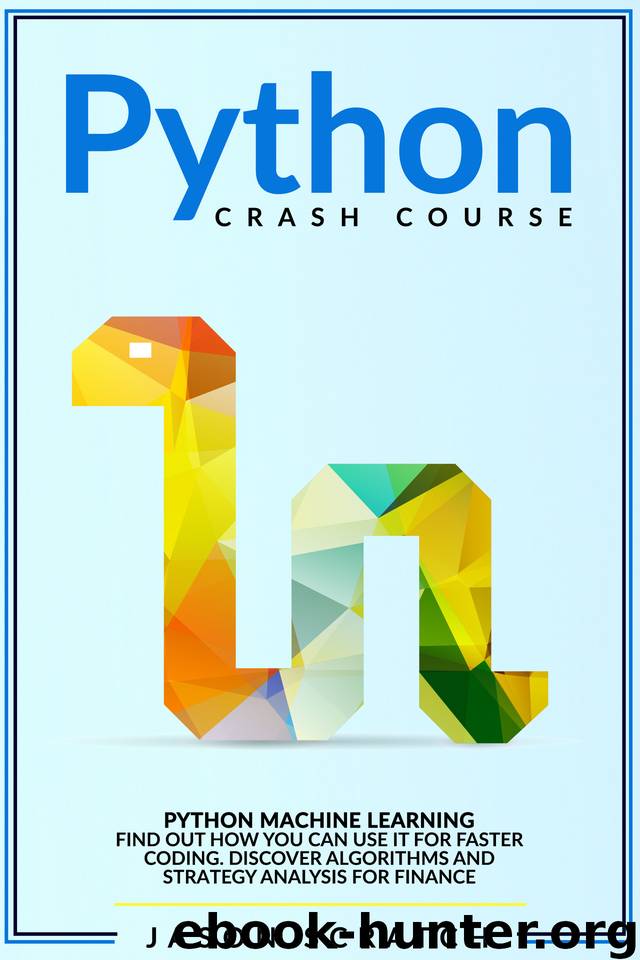Python Crash Course: Python Machine Learning. Find out how you can use it for faster coding. Discover algorithms and strategy analysis for finance. by Scratch Jason

Author:Scratch, Jason [Scratch, Jason]
Language: eng
Format: epub, azw3
Published: 2020-07-19T16:00:00+00:00
How to Import a Module
We have talked about importing a module without really explaining what happens behind in Python. Imports are a very fundamental concept in Python programming structure. In this section, we are going to cover in-depth how really Python imports modules within a program. Python follows three steps to import a file or a module within the work environment of a program. The first step consists of finding the file that contains the module. The second step consists of compiling the module to a byte-code if required. Finally, the third step runs the code within the module file to build the objects that are defined. These three steps are run only when the module is imported for the first time during the execution of a program. This module and all its objects are loaded in the memory. When the module is imported further in the program, it skips all three steps and just fetch the objects defined by the module and are saved in memory.
At the very first step of importing a module, Python has to find the module file location. Note that, so far in the examples we presented, we used import without providing the complete path of the module or extension .py. We just used import math, or import file2.py (an example of the earlier section). Python import statement omits the extension and the path. We just simply import a module by its name. The reason for this is that Python has a module that looks for paths called 'search path module'. This module is used specifically to find the path of module files that are imported by the import statements.
In some cases, you might need to configure the path search of modules to be able to use new modules that are not part of the standard library. You need to customize it to include these new modules. The search path is simply the concatenation of the home directory, directories of PYTHONPATH, directories of the standard library, and optionally if the content of files with extension .pth when they exist. The home directory is set automatically by the system to a directory of Python executable when launched from the interactive session, or it can be modified to the working directory where your program is saved. This directory is the first to be searched when import a module is run without a path. Hence, if your home directory points to a directory that includes your program along with the modules, importing these modules does not require any path specification.
The directory of the standard library is also searched automatically. This directory contains all default libraries that come with Python. The directories of PYTHONPATH can be set to point toward the directory of new modules that are developed. In fact, PTYHONPATH is an environment variable that contains a list of directories that contains Python files. When PTYHONPATH is set, all these paths are included in the Python environment and the search path directory would search these directories too when importing modules.
Download
Python Crash Course: Python Machine Learning. Find out how you can use it for faster coding. Discover algorithms and strategy analysis for finance. by Scratch Jason.azw3
This site does not store any files on its server. We only index and link to content provided by other sites. Please contact the content providers to delete copyright contents if any and email us, we'll remove relevant links or contents immediately.
Hello! Python by Anthony Briggs(10198)
The Mikado Method by Ola Ellnestam Daniel Brolund(10106)
OCA Java SE 8 Programmer I Certification Guide by Mala Gupta(10043)
Algorithms of the Intelligent Web by Haralambos Marmanis;Dmitry Babenko(8588)
Sass and Compass in Action by Wynn Netherland Nathan Weizenbaum Chris Eppstein Brandon Mathis(7969)
Grails in Action by Glen Smith Peter Ledbrook(7942)
Test-Driven iOS Development with Swift 4 by Dominik Hauser(7900)
The Well-Grounded Java Developer by Benjamin J. Evans Martijn Verburg(7841)
Windows APT Warfare by Sheng-Hao Ma(7664)
Layered Design for Ruby on Rails Applications by Vladimir Dementyev(7393)
Blueprints Visual Scripting for Unreal Engine 5 - Third Edition by Marcos Romero & Brenden Sewell(7295)
Secrets of the JavaScript Ninja by John Resig Bear Bibeault(6739)
Kotlin in Action by Dmitry Jemerov(5369)
Solidity Programming Essentials by Ritesh Modi(4469)
Hands-On Full-Stack Web Development with GraphQL and React by Sebastian Grebe(4400)
WordPress Plugin Development Cookbook by Yannick Lefebvre(4279)
Unity 3D Game Development by Anthony Davis & Travis Baptiste & Russell Craig & Ryan Stunkel(4188)
Functional Programming in JavaScript by Mantyla Dan(4170)
The Ultimate iOS Interview Playbook by Avi Tsadok(4162)
